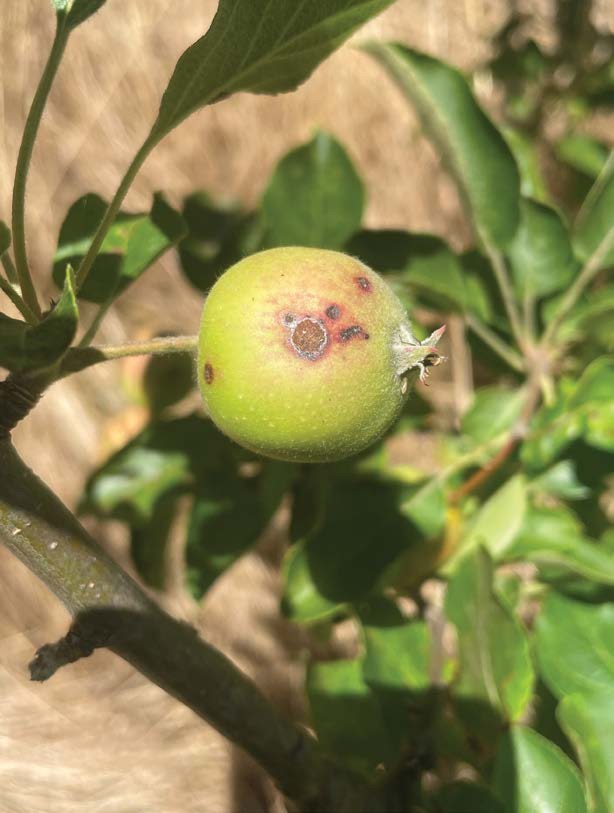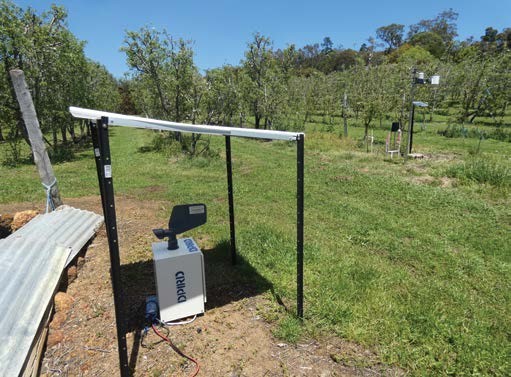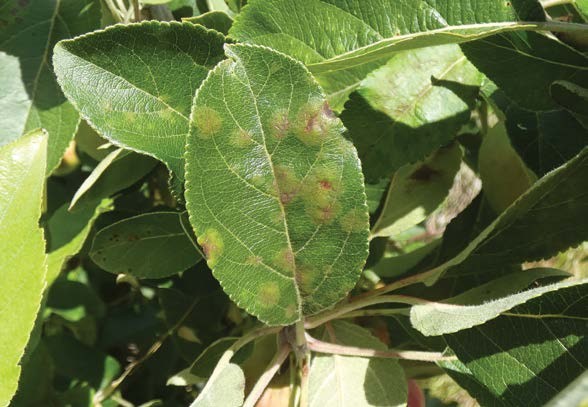POMEWEST apple scab
APPLE SCAB
PROJECT
underway
A new project aimed at improving the management of apple scab in Australia has commenced. Apple scab, caused by the fungus Venturia inaequalis, is a relatively new disease in Western Australian (WA) orchards. A strong focus of the project is on the lifecycle of the disease under WA conditions and optimal management strategies for its control.
Words Dr Andrew Taylor, Department Primary Industries and Regional Development
THE four-year project is a collaboration between the Department of Primary Industries and Regional Development (DPIRD), Curtin University’s Centre for Crop and Disease Management (CCDM) and the Solving Antimicrobial Resistance in Agribusiness, Food and Environments (SAAFE) CRC.
There are three main components of the project :
1. Cataloguing the resistance genes in the germplasm collection of the Australian National Apple Breeding Program (ANABP).
2. Measuring the prevalence and extent of any fungicide resistance within the Australian population of V. inaequalis.
3. Understanding the disease development in WA orchards with the assistance of decision support systems.
Cataloguing the resistance genes in the ANABP
Historically, the ANABP has selected apples based on their unique appearance, taste, crisp and crunchy texture, long-term storage capabilities, visual appeal and yield. This focus has been successful with the release of several commercially successful cultivars including Cripps Pink (Pink Lady®), Cripps red (Sundowner®) and ANABP 01A (Bravo®, Soluna®). However, due to a lack of selection pressure, with the previous absence of apple scab, all of these varieties are considered susceptible to infection.
Globally, there are certain species of apples that are naturally resistant to different strains of the apple scab fungus. Some of the genes associated with this resistance have been determined using molecular techniques. The project will screen the 300 cultivars used as breeding parents in the ANABP, to determine if any of these genes are present. Pot trials will confirm if the cultivars found with resistant genes exhibit field resistance. The aim is to identify cultivars that can be included as parents in ANABP crosses, for enhanced disease resistance that can be an additional trait contributing to the quality parameters observed in previously released commercial cultivars.
Measuring the prevalence and extent of any fungicide resistance
The current major apple cultivars grown in Australia are susceptible to apple scab infection. The dominant management option growers use is through the timely application of fungicides. Unfortunately, the fungus V. inaequalis, is considered by world authorities a high risk for developing resistance to these fungicides.
In Australia, there has been no ongoing testing of V. inaequalis’ susceptibility to the main fungicide groups registered for its management.
The project aims to collect V. inaequalis isolates from across major apple growing regions in Australia, to test and determine a baseline concentration for control Outcomes will be presented to industry groups, so that management practices can be amended to minimise potential outbreaks. The collection of isolates also represents an opportunity to investigate whether any genetic differences occur between the apple scab populations in different growing regions or states.


Sampling will be required for three consecutive seasons to consider the impact of weather on disease prevalence. Complimentary sample packs are available to support apple scab sampling.
Understanding the disease development in Western Australian
WA was officially free from the presence of apple scab until 2009. Consequently, knowledge of disease development and the lifecycle of V. inaequalis is less advanced compared to growing regions where it has been thoroughly researched. A particular unknown is when the overwintering spores of the fungus are released in spring to start the disease curve. To understand this process, newer types of spore traps are being placed in orchards to determine the presence and number of apple scab spores in the air each day over the growing season.

In conjunction with spore trapping, weather stations will be installed and connected to the RIMpro decision support system. RIMpro aids in apple scab management by assessing the risk based on past and forecasted environmental conditions. This enables growers to make more informed decisions on spray timing and chemistry. As RIMpro was developed in the Northern Hemisphere and not under WA environmental conditions, pore traps will determine if calibrations are required for WA conditions.
The project seeking orchardists with apple scab presence in the southern growing regions of WA to volunteer for spore traps and weather stations. Volunteers can remain anonymous and will have access to a weather station and the data it produces for the life of the project and weekly RIMpro updates during the season.
MORE INFORMATION
If you would like a sample pack or interested in volunteering to host a spore trap, please contact applescab@ dpird.wa.gov.au
Webinars and field days are planned throughout the life of the project to provide valuable updates to growers and industry.
